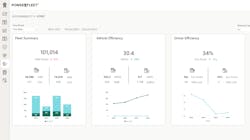Powerfleet launches sustainability monitoring tool for fleets
Transportation IoT company Powerfleet has added a new sustainability data visualization solution to its Unity fleet intelligence platform. The solution will help fleets enhance fuel efficiency and maintenance operations, reducing overall costs while minimizing a carrier’s carbon footprint, according to a company press release.
“Climate change, political initiatives to reduce carbon emissions, and heightening public concerns and social demand for green practices have made sustainable technology a top motivator for decision-makers across the board,” said Powerfleet CEO Steve Towe. “We recognize the responsibility we have as trusted advisors to provide green technologies that not only benefit the fleet itself but that touch and help unify a business’s entire operation and ESG strategy.”
Data science and insights from Unity power the solution. Powerfleet’s Unity platform is agnostic, working with any IoT/telematics device, vehicle, or business system, and provides parameters beyond those from Original Equipment Manufacturers (OEMs), according to the release.
Unity’s sustainability dashboard provides executive-level insights, real-time monitoring and alerts for fleet managers, and a mobile app for drivers.
Insights can be pulled for a specific trip up to a full year, including:
- CO2 emissions: Discover overall tons of CO2 produced and saved by your fleet.
- Vehicle efficiency: Identify high- and low-emission vehicles in real-time. Reduce CO2 by determining which vehicles need maintenance or even replacement with electric vehicles.
- Eco scoring: Track emission-increasing behaviors, such as idling, per driver. Gain insights into “miles lost” from inefficient driving and the opportunity for positive or incentive-based training.
- Budgeting and planning: Use historical data on vehicle efficiency and eco-scoring to predict fuel and energy use.
- EV conversion: Detailed fleet summaries of both electric and gasoline-powered vehicles serve as a guide for electrification. Narrow down to the make, model, year, amount used, and beyond in correlation with the tailpipe emissions of each vehicle. Determine which are the cleanest, which to switch out, and when with EVs.
Additional data-powered applications spanning visibility, maintenance, fuel, and compliance are expected to launch through 2024.
About the Author
FleetOwner Staff
Our Editorial Team
Kevin Jones, Editorial Director, Commercial Vehicle Group
Josh Fisher, Editor-in-Chief
Jade Brasher, Senior Editor
Jeremy Wolfe, Editor
Jenna Hume, Digital Editor
Eric Van Egeren, Art Director
